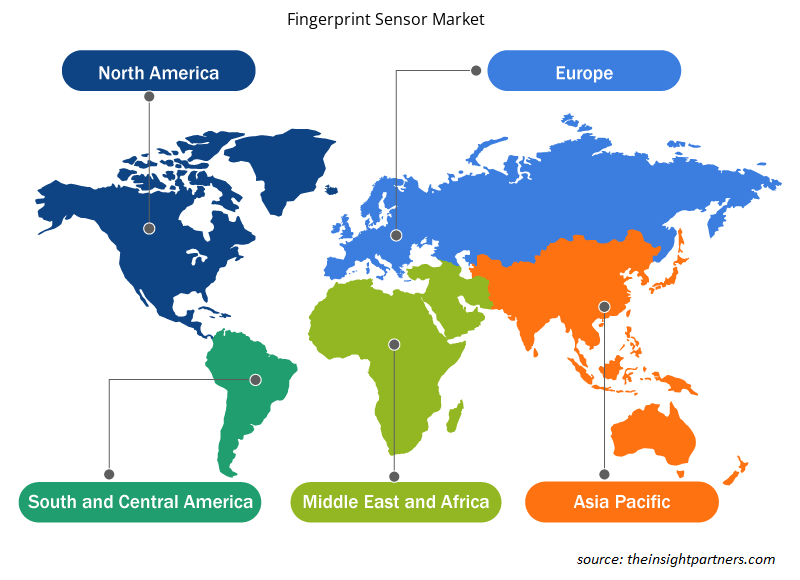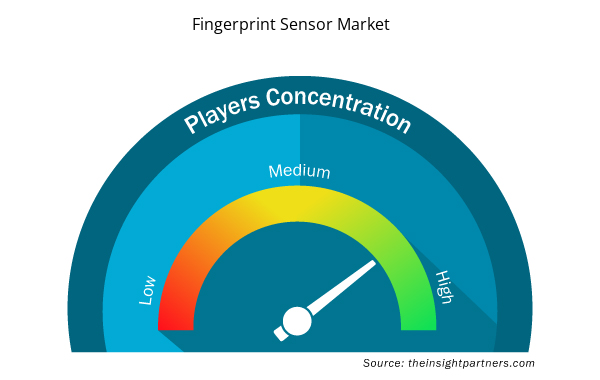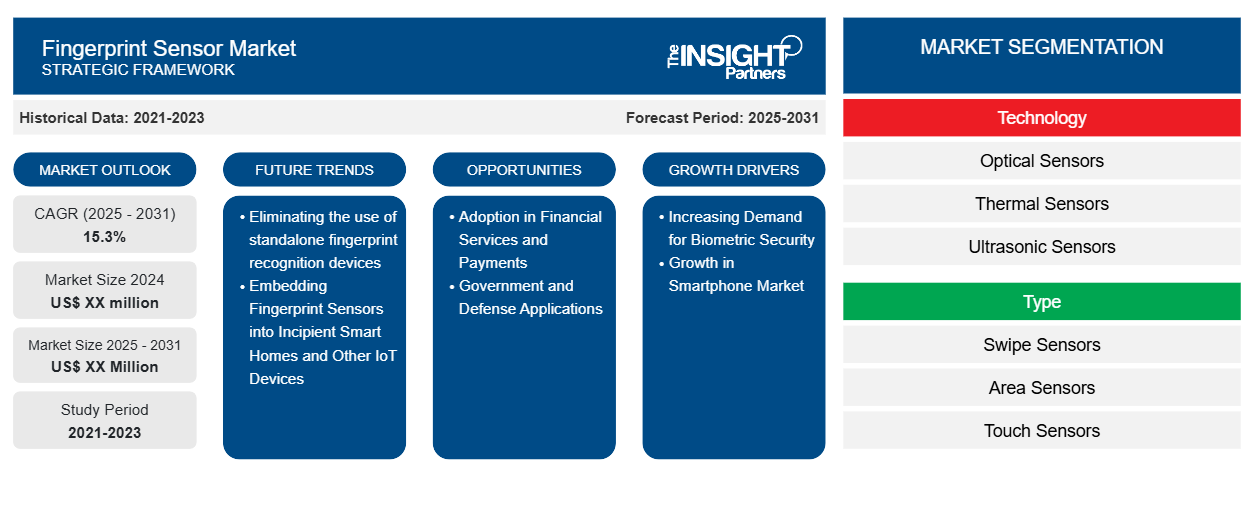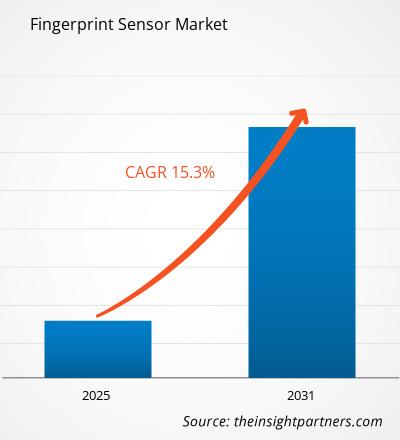指纹传感器市场预计在 2024 年至 2031 年期间的复合年增长率为 15.3%,市场规模将从 2024 年的 XX 百万美元扩大到 2031 年的 XX 百万美元。
报告按技术(光学传感器、热传感器、超声波传感器、电容式传感器和压力传感器)、类型(滑动传感器、区域传感器和触摸传感器)、最终用户行业(军事和国防、消费电子、银行和金融、医疗保健、商业安全和政府)细分。全球分析进一步细分为区域和主要国家。报告以美元为单位提供上述分析和细分的价值。
报告目的
Insight Partners 的《指纹传感器市场》报告旨在描述当前形势和未来增长、主要驱动因素、挑战和机遇。这将为各种业务利益相关者提供见解,例如:
- 技术提供商/制造商:了解不断变化的市场动态并了解潜在的增长机会,从而能够做出明智的战略决策。
- 投资者:对市场增长率、市场财务预测以及整个价值链中存在的机会进行全面的趋势分析。
- 监管机构:监管市场政策和警察活动,旨在最大限度地减少滥用行为,维护投资者的信任和信心,维护市场的完整性和稳定性。
指纹传感器市场细分
技术
- 光学传感器
- 热传感器
- 超声波传感器
- 电容式传感器 Sensors
- 压力传感器
类型
- 滑动传感器
- 区域传感器
- 触摸传感器
终端用户行业
- 军事和国防
- 消费电子产品
- 银行与金融
- 卫生保健
- 商业安全
- 政府
地理
- 北美
- 欧洲
- 亚太
- 南美洲和中美洲
- 中东和非洲
定制此报告以满足您的需求
您可以免费定制任何报告,包括本报告的部分内容、国家级分析、Excel 数据包,以及为初创企业和大学提供优惠和折扣
- 获取此报告的关键市场趋势。这个免费样品将包括数据分析,从市场趋势到估计和预测。
指纹传感器市场增长动力
- 生物识别安全需求不断增长:人们对数据安全和欺诈预防的担忧日益增加,推动了指纹传感器的采用。随着生物识别身份验证成为安全访问个人和财务信息的首选方法,智能手机、笔记本电脑和安全系统中对指纹传感器的需求正在加速增长。
- 智能手机市场增长:具有指纹扫描功能的智能手机使用率不断提高,这是市场增长的主要推动力。随着移动设备制造商将指纹传感器集成到其产品中,对先进且经济高效的指纹传感器的需求不断增加。
指纹传感器市场未来趋势
- 消除独立指纹识别设备的使用:指纹传感器行业的主要趋势之一是越来越依赖将这些传感器集成到消费电子产品中,尤其是智能手机、平板电脑和可穿戴设备。事实上,如今大多数制造商已将指纹识别功能嵌入到高端设备中,作为标准规格,允许使用移动服务,例如应用程序支付、设备解锁甚至访问某些应用程序。鉴于消费者对集成和安全体验的需求日益增长,这一趋势可能会持续下去。
- 将指纹传感器嵌入到新兴智能家居和其他物联网设备中:随着物联网领域的发展,将指纹传感器嵌入智能家电和物联网设备的趋势日益增长。这些传感器提高了智能锁和其他家庭安全系统的安全性,以及允许使用指纹解锁保险箱甚至控制房屋内电器的访问设备。这一趋势还表明,生物识别在更广泛的连接和自动化系统中的使用日益增多。
指纹传感器市场机会
- 在金融服务和支付领域的应用:指纹传感器市场拥有巨大的机遇,尤其是随着移动银行、数字钱包和非接触式支付的兴起。指纹传感器提供了一种安全便捷的金融交易身份验证方式,降低了欺诈风险并提高了消费者信心。随着越来越多的人使用移动银行和支付应用程序,指纹传感器正成为金融行业生物识别安全的热门选择,为市场创造了巨大的潜在机会。
- 政府和国防应用:政府和国防组织正在投资指纹传感器技术,以实现安全访问控制、身份验证和边境安全。随着这些领域对可靠生物识别系统的需求不断增长,指纹传感器供应商有越来越多的机会满足这些高安全性要求。
指纹传感器市场区域洞察
Insight Partners 的分析师已详尽解释了预测期内影响指纹传感器市场的区域趋势和因素。本节还讨论了北美、欧洲、亚太地区、中东和非洲以及南美和中美洲的指纹传感器市场细分和地理位置。

- 获取指纹传感器市场的区域特定数据
指纹传感器市场报告范围
| 报告属性 | 细节 |
|---|---|
| 2024 年的市场规模 | XX 百万美元 |
| 2031 年市场规模 | XX 百万美元 |
| 全球复合年增长率(2025 - 2031) | 15.3% |
| 史料 | 2021-2023 |
| 预测期 | 2025-2031 |
| 涵盖的领域 | 按技术分类
|
| 覆盖地区和国家 | 北美
|
| 市场领导者和主要公司简介 |
|
指纹传感器市场参与者密度:了解其对业务动态的影响
指纹传感器市场正在快速增长,这得益于终端用户需求的不断增长,而这些需求又源于消费者偏好的不断变化、技术进步以及对产品优势的认识不断提高等因素。随着需求的增加,企业正在扩大其产品范围,进行创新以满足消费者的需求,并利用新兴趋势,从而进一步推动市场增长。
市场参与者密度是指在特定市场或行业内运营的企业或公司的分布情况。它表明在给定市场空间中,相对于其规模或总市场价值,有多少竞争对手(市场参与者)存在。
在指纹传感器市场运营的主要公司有:
- 蒸气传感器
- 艾森斯有限责任公司
- Stratio 公司
- 维康视科技
- 可弯曲
免责声明:上面列出的公司没有按照任何特定顺序排列。

- 获取指纹传感器市场顶级关键参与者概述
主要卖点
- 全面覆盖:报告全面涵盖了指纹传感器市场的产品、服务、类型和最终用户的分析,提供了整体概况。
- 专家分析:报告基于对行业专家和分析师的深入了解而编写。
- 最新信息:该报告涵盖了最新信息和数据趋势,确保了其与业务的相关性。
- 定制选项:此报告可以定制以满足特定客户要求并恰当地适应业务策略。
因此,指纹传感器市场研究报告有助于引领解码和了解行业情景和增长前景。尽管可能存在一些合理的担忧,但本报告的总体优势往往大于劣势。
- 历史分析(2 年)、基准年、预测(7 年)及复合年增长率
- PEST 和 SWOT 分析
- 市场规模价值/数量 - 全球、区域、国家
- 行业和竞争格局
- Excel 数据集



Report Coverage
Revenue forecast, Company Analysis, Industry landscape, Growth factors, and Trends

Segment Covered
This text is related
to segments covered.

Regional Scope
North America, Europe, Asia Pacific, Middle East & Africa, South & Central America

Country Scope
This text is related
to country scope.
常见问题
Some of the customization options available based on the request are an additional 3-5 company profiles and country-specific analysis of 3-5 countries of your choice. Customizations are to be requested/discussed before making final order confirmation# as our team would review the same and check the feasibility
Embedding Fingerprint Sensors into Incipient Smart Homes and Other IoT Devices is likely to remain a key trend in the market.
Key players in the Fingerprint Sensor Market include Shenzhen Goodix Technology Co., Ltd, Fingerprints, Synaptics Incorporated, Apple Inc, NEXT Biometrics, Novatek Microelectronics Corp., Qualcomm Technologies, Inc. , Goodix, Fingerprint Cards, and Egis Technology
The major factors driving the Fingerprint Sensor Market are:
1. A Growth in Acceptance of Biometric Security Systems.
2.Technological Improvements Relating to the Fingerprint Sensor
The Fingerprint Sensor Market is estimated to witness a CAGR of 15.3% from 2023 to 2031
Trends and growth analysis reports related to Electronics and Semiconductor : READ MORE..
The List of Companies
1. Vaporsens
2. ISENSE, LLC
3. Stratio, Inc.
4. Vkansee Technology
5. Flexenable
6. Egis Technology Inc.
7. Bio Recognition Systems
8. AuthenTec
9. NEC Corporation
10. Touch Biometrix
The Insight Partners performs research in 4 major stages: Data Collection & Secondary Research, Primary Research, Data Analysis and Data Triangulation & Final Review.
- Data Collection and Secondary Research:
As a market research and consulting firm operating from a decade, we have published and advised several client across the globe. First step for any study will start with an assessment of currently available data and insights from existing reports. Further, historical and current market information is collected from Investor Presentations, Annual Reports, SEC Filings, etc., and other information related to company’s performance and market positioning are gathered from Paid Databases (Factiva, Hoovers, and Reuters) and various other publications available in public domain.
Several associations trade associates, technical forums, institutes, societies and organization are accessed to gain technical as well as market related insights through their publications such as research papers, blogs and press releases related to the studies are referred to get cues about the market. Further, white papers, journals, magazines, and other news articles published in last 3 years are scrutinized and analyzed to understand the current market trends.
- Primary Research:
The primarily interview analysis comprise of data obtained from industry participants interview and answers to survey questions gathered by in-house primary team.
For primary research, interviews are conducted with industry experts/CEOs/Marketing Managers/VPs/Subject Matter Experts from both demand and supply side to get a 360-degree view of the market. The primary team conducts several interviews based on the complexity of the markets to understand the various market trends and dynamics which makes research more credible and precise.
A typical research interview fulfils the following functions:
- Provides first-hand information on the market size, market trends, growth trends, competitive landscape, and outlook
- Validates and strengthens in-house secondary research findings
- Develops the analysis team’s expertise and market understanding
Primary research involves email interactions and telephone interviews for each market, category, segment, and sub-segment across geographies. The participants who typically take part in such a process include, but are not limited to:
- Industry participants: VPs, business development managers, market intelligence managers and national sales managers
- Outside experts: Valuation experts, research analysts and key opinion leaders specializing in the electronics and semiconductor industry.
Below is the breakup of our primary respondents by company, designation, and region:

Once we receive the confirmation from primary research sources or primary respondents, we finalize the base year market estimation and forecast the data as per the macroeconomic and microeconomic factors assessed during data collection.
- Data Analysis:
Once data is validated through both secondary as well as primary respondents, we finalize the market estimations by hypothesis formulation and factor analysis at regional and country level.
- Macro-Economic Factor Analysis:
We analyse macroeconomic indicators such the gross domestic product (GDP), increase in the demand for goods and services across industries, technological advancement, regional economic growth, governmental policies, the influence of COVID-19, PEST analysis, and other aspects. This analysis aids in setting benchmarks for various nations/regions and approximating market splits. Additionally, the general trend of the aforementioned components aid in determining the market's development possibilities.
- Country Level Data:
Various factors that are especially aligned to the country are taken into account to determine the market size for a certain area and country, including the presence of vendors, such as headquarters and offices, the country's GDP, demand patterns, and industry growth. To comprehend the market dynamics for the nation, a number of growth variables, inhibitors, application areas, and current market trends are researched. The aforementioned elements aid in determining the country's overall market's growth potential.
- Company Profile:
The “Table of Contents” is formulated by listing and analyzing more than 25 - 30 companies operating in the market ecosystem across geographies. However, we profile only 10 companies as a standard practice in our syndicate reports. These 10 companies comprise leading, emerging, and regional players. Nonetheless, our analysis is not restricted to the 10 listed companies, we also analyze other companies present in the market to develop a holistic view and understand the prevailing trends. The “Company Profiles” section in the report covers key facts, business description, products & services, financial information, SWOT analysis, and key developments. The financial information presented is extracted from the annual reports and official documents of the publicly listed companies. Upon collecting the information for the sections of respective companies, we verify them via various primary sources and then compile the data in respective company profiles. The company level information helps us in deriving the base number as well as in forecasting the market size.
- Developing Base Number:
Aggregation of sales statistics (2020-2022) and macro-economic factor, and other secondary and primary research insights are utilized to arrive at base number and related market shares for 2022. The data gaps are identified in this step and relevant market data is analyzed, collected from paid primary interviews or databases. On finalizing the base year market size, forecasts are developed on the basis of macro-economic, industry and market growth factors and company level analysis.
- Data Triangulation and Final Review:
The market findings and base year market size calculations are validated from supply as well as demand side. Demand side validations are based on macro-economic factor analysis and benchmarks for respective regions and countries. In case of supply side validations, revenues of major companies are estimated (in case not available) based on industry benchmark, approximate number of employees, product portfolio, and primary interviews revenues are gathered. Further revenue from target product/service segment is assessed to avoid overshooting of market statistics. In case of heavy deviations between supply and demand side values, all thes steps are repeated to achieve synchronization.
We follow an iterative model, wherein we share our research findings with Subject Matter Experts (SME’s) and Key Opinion Leaders (KOLs) until consensus view of the market is not formulated – this model negates any drastic deviation in the opinions of experts. Only validated and universally acceptable research findings are quoted in our reports.
We have important check points that we use to validate our research findings – which we call – data triangulation, where we validate the information, we generate from secondary sources with primary interviews and then we re-validate with our internal data bases and Subject matter experts. This comprehensive model enables us to deliver high quality, reliable data in shortest possible time.


 获取此报告的免费样本
获取此报告的免费样本